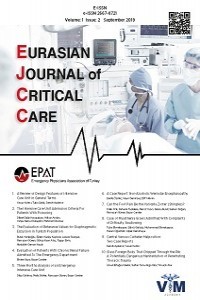The Osborn Wave and Ethanol?
The Osborn Wave and Ethanol?
Osborn Wave, Ethanol, Cardiac Arrest, Emergency Room,
___
- 1. Gussak I, Bjerregaard P, Egan TM, Chaitman BR: ECG phenomenon called the J wave: history, pathophysiology, and clinical significance. J Electrocardiol 1995;28:49-58.
- 2. Osborn JJ. Experimental hypothermia; respiratory and blood pH changes in relation to cardiac function. Am J Physiol 1953;175:389-98.
- 3. Siniorakis E, Arvanitakis S, Roulia G, Voutas P, Karidis C. Myocardial damage after prolonged accidental hypothermia: a case report. J Med Case Rep. 2009;3:8459.
- 4. Maruyama M, Atarashi H, Ino T, KishidaH. Osborn waves associated with ventricular fibrillation in a patient with vasospastic angina. J Cardiovasc Electrophysiol 2002;13:486-9.
- 5. Randall CB. Disposition of toxic drugs and chemicals in man. 7th ed. Foster City (CA): biomedical Publications; 2004. p.411-13.
- 6. American Heart Association (2014) Alcohol and He¬art Health AHA Recommendation The web site: hhtp//www.heart.org.
- 7. Wijnandts PR., JAP Van der Sloot, WK Lagrand. "Osborn waves in hypothermia. Case report and clinical images." Netherlands journal of critical care 14 (2010):111-112.
- Başlangıç: 2019
- Yayıncı: Acil Tıp Uzmanları Derneği
Serkan DOĞAN, Utku Murat KALAFAT, Rabia Birsen TAPKAN, Ramiz YAZICI, Bensu BULUT, Büşra BİLDİK, Doğaç Niyazi ÖZÜÇELİK, Basar CANDER
Thyrotoxic Hypokalemic Periodic Paralysis: Case Report
Utku KALAFAT, Busra BILDIK, Gulcan CAGLAR, Serkan DOGAN, Basar CANDER
Evaluation of fatal trauma cases presented to the emergency room
Abdullah ALGIN, Ertuğrul ALTINBİLEK, Ahmet Burak ERDEM, Miray TÜMER
Tuba EKMEKYAPAR, Muhammed EKMEKYAPAR, Şükrü GÜRBÜZ, Hakan OĞUZTÜRK
A CASE REPORT: HERPES ZOSTER WITH SACRAL INVOLVEMENT
Muhammed EKMEKYAPAR, Tuba EKMEKYAPAR, Hakan OĞUZTÜRK, Şükrü GÜRBÜZ, Hasan GÖKÇE
A Case of Suicide by Hara-Kiri in Turkey
Hüseyin METİN, Begüm SAKIN, Bahadir TASLİDERE, Bedia GÜLEN, Ertan SÖNMEZ
PREDICTORS OF EARLY AND LATE MORTALITY IN MULTITRAUMA PATIENTS
Burcu YAVUZ, Mehmet ERDOĞAN, Şahin ÇOLAK
Hasan GÖKÇE, Mehmet Ediz SARIHAN, Muhammed EKMEKYAPAR
Management of a Patient With a Single Coronary Artery Anomaly During a Heart Attack
Evaluation of low back pain prevalence in emergency department workers
Dilek ATİK, Basar CANDER, Cesareddin DİKMETAŞ, Bensu BULUT, Emre GÖKÇEN, İbrahim ÇALTEKİN, Levent ALBAYRAK, Hasan KAYA
